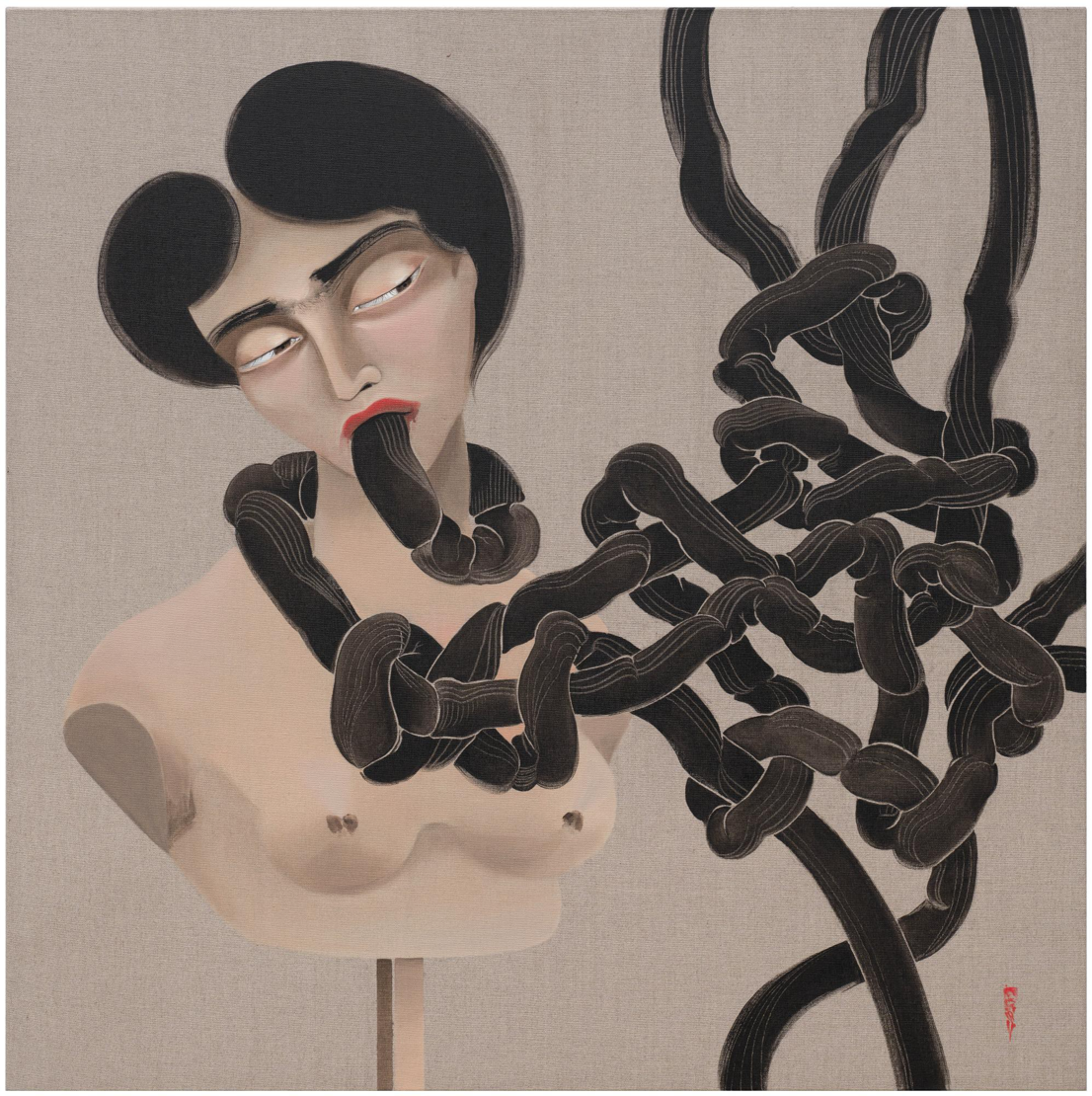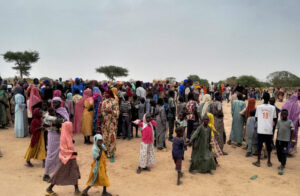The Kurdish artist draws on Baghdad’s miniature tradition, self-portraiture, plant bacteria and neurosculpting for artworks that provoke a gut reaction
In 2006, the artist Hayv Kahraman moved to the US, then occupying her homeland, Iraq, and began painting a woman who has been a fixture of her work ever since. With parchment-pale skin, a swoosh of raven hair, scarlet lips and strong brows, this figure recalls the characters set against unadorned backgrounds in 12th-century Baghdad’s miniature painting, while her apple-round breasts and cool, heavy-lidded gaze suggest a quattrocento nude, rendered with the clean lines of Japanese prints.
It is a composite identity its maker understands well. Kahraman was 11 when she was smuggled out of Iraq during the first Gulf war. Her family settled in Sweden, where she spent her teens; she now lives in Los Angeles. “As an immigrant, I’ve always felt on the periphery of society,” she says.
Watching her mother work as a translator for government agencies, Kahraman saw the demand for refugees to repeat their trauma. “It creates an economy of pain where suffering becomes a currency,” she says. “So how do we get unstuck? How do we not only survive but thrive?”
In the past 15 years she has used her painted women to investigate the refugee condition from often surprising angles. The figures have become contortionists; canvases have been sliced up and rewoven into abstract patterns, in an allegory of the fragmented nature of memory, culture and trauma. A recent Covid-centric series interrogated the martial language of immunology, in which the human fortress is seen to be “invaded” or “colonised” by foreign bodies.
Her latest exhibition, Gut Feelings, draws on recent research into the possibility of actively “rewiring” neural pathways through the gut microbiome. “The bacteria in our gut is responsible for regulating hormones like dopamine and serotonin that give us feelings,” she says.
It is clear, though, from her work’s unsettling tone, that she sees any restorative process as complicated. Beauty is tempered by a jolt of body horror as the women in her paintings strike acrobat poses, entangled in thick, intestine-like nets, or crouch low, passing ropes of lilac guts between them. In small canvases she calls “neurobusts”, a woman’s body has been fragmented into a bust and displayed on a steel rod like a museum artefact. Sausage-like innards protrude from her mouth. Umbilical cords and blowjobs come to mind. These challenging images make us reflect on what we are taught to consider “normal”: “I was brainwashed into thinking anything Euro-American-centric is the ideal,” Kahraman says.
The ambiguity that permeates Kahraman’s work goes far beyond its mix of the gorgeous and grotesque. Are these female prisoners or nest-builders, nurtured or force-fed? “It’s not about erasing the pain and entanglement,” she says. “It’s about thinking, feeling and working through it.”
Body of work – recent pieces by Kahraman
Entanglements With Torshi, 2021
Kahraman has found novel ways to “collaborate with microbes” in her paintings exploring the gut microbiome. The lilac in this painting comes from the Middle Eastern beetroot torshi. “Bacteria permeates the vegetables to create this fermented food,” she says. “My mum and I used to paint with it when I was a kid.”
Neurobust No 1, 2021 (pictured top)
Kahraman’s interest in neuroscience began with the loss of her mother. The artist discovered that one of the last books she had been reading before her death concerned “neurosculpting”, the potential for changing neural pathways that were previously considered set. “In the field of PTSD, this is massive,” she says. “It was interesting that she, an Iraqi immigrant, had chosen this book.”
Beard-Gut-Brain Axis, 2021
Kahraman has begun experimenting with painting on flax, another product of bacteria permeating a plant – and what linen is made from. Linen had a strong association with Venice, “the heart of European aesthetics”, she says. “I want to dismantle that.”
Entanglements No 1, 2021
The artist typically uses her own body as a model, however she doesn’t see her figures as self-portraits. “It’s not individualistic; it’s more about creating a collective of women,” she says.
Hayv Kahraman: Gut Feelings is at the Mosaic Rooms, London, from 25 February until 29 May.
An erosion of democratic norms. An escalating climate emergency. Corrosive racial inequality. A crackdown on the right to vote. Rampant pay inequality. America is in the fight of its life. If you can, please make a gift today to fund our reporting in 2022.
For 10 years, the Guardian US has brought an international lens with a focus on justice to its coverage of America. Globally, more than 1.5 million readers, from 180 countries, have recently taken the step to support the Guardian financially – keeping us open to all, and fiercely independent. We couldn’t do this without readers like you.
With no shareholders or billionaire owner, we can set our own agenda and provide trustworthy journalism that’s free from commercial and political influence, offering a counterweight to the spread of misinformation. When it’s never mattered more, we can investigate and challenge without fear or favour. It is reader support that makes our high-impact journalism possible and gives us the energy to keep doing journalism that matters.
Unlike many others, Guardian journalism is available for everyone to read, regardless of what they can afford to pay. We do this because we believe in information equality.
We aim to offer readers a comprehensive, international perspective on critical events shaping our world. We are committed to upholding our reputation for urgent, powerful reporting on the climate emergency, and made the decision to reject advertising from fossil fuel companies, divest from the oil and gas industries, and set a course to achieve net zero emissions by 2030.




